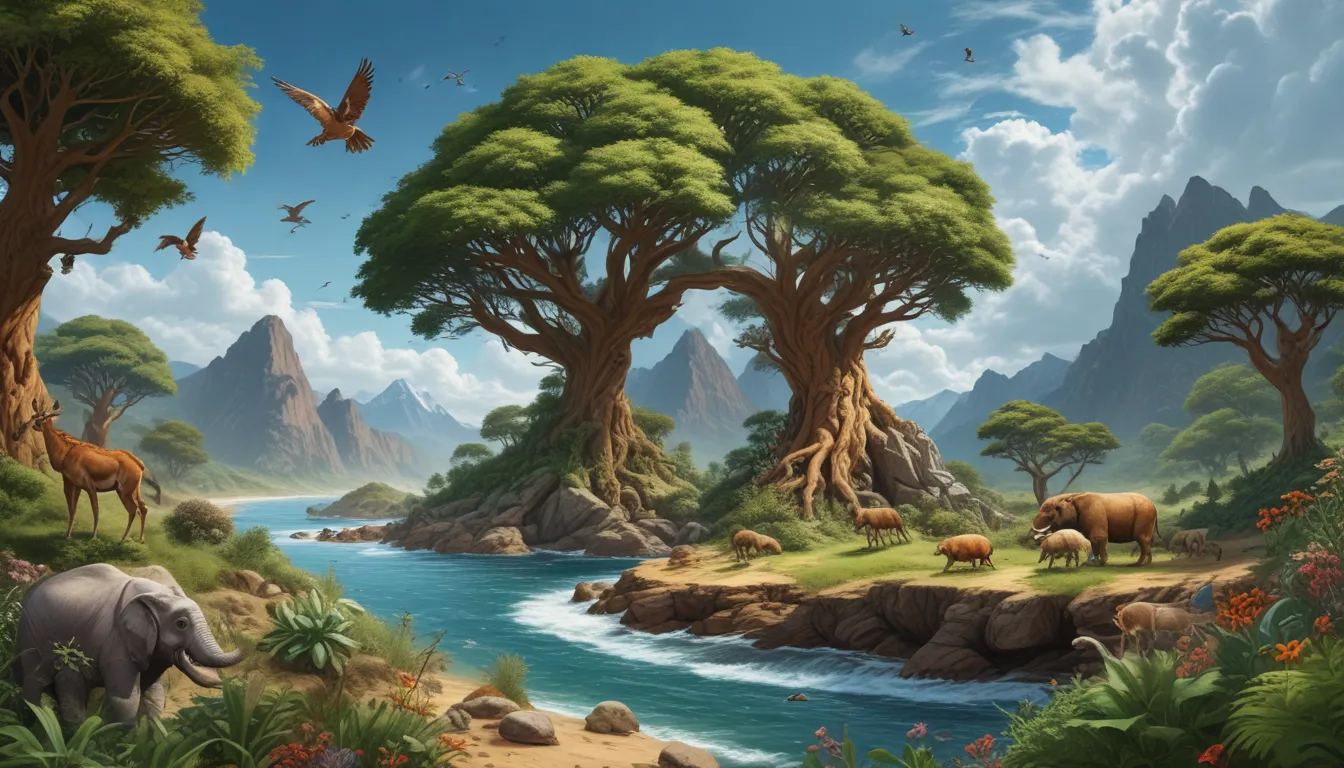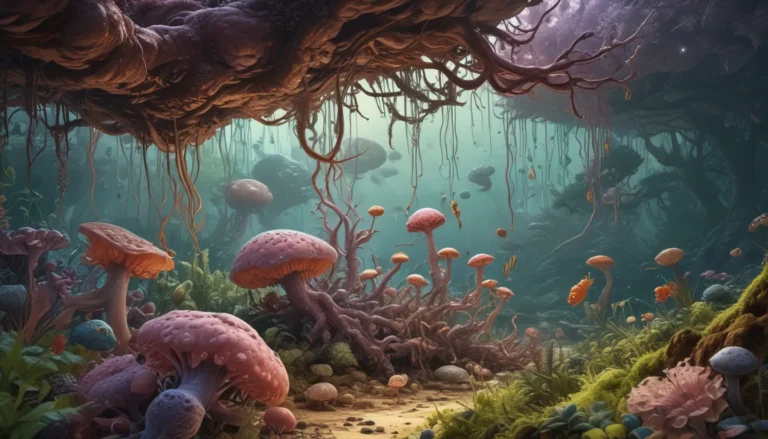A Note About Images: The images used in our articles are for illustration purposes only and may not exactly match the content. They are meant to engage readers, but the text should be relied upon for accurate information.
Embark on a captivating journey through Earth’s history, unraveling the secrets of our planet’s ever-changing landscape. Delve into the fascinating world of continental drift, where ancient landmasses dance across oceans, shaping life’s diversity. Discover the marvels of adaptive radiation, as species evolve and flourish in unique ecological niches. Explore the intricacies of speciation, the very process that gives rise to Earth’s astonishing array of life forms. Prepare to be amazed by the intricate web of evolutionary biogeography, where science and nature intertwine in a breathtaking tapestry of discovery.
Key Takeaways:
- Evolutionary biogeography studies how animals and plants have spread across the world, helping us understand their history and the impact of things like climate and land formations on their evolution.
- By studying evolutionary biogeography, scientists can learn how species have adapted to different environments, predict how they might respond to climate change, and help protect endangered species and their habitats.
Evolutionary Biogeography: Unveiling the Distribution of Species
Evolutionary biogeography is a branch of biology that explores how species have evolved and dispersed over time in relation to geographic factors such as climate, land formations, and migration patterns.
The study of evolutionary biogeography helps to understand the historical relationships between different species. By analyzing the distribution patterns of species, scientists can uncover important clues about their evolutionary history and the processes that have shaped Earth’s biodiversity.
The Galapagos Islands played a pivotal role in the development of evolutionary biogeography. Charles Darwin’s visit to the Galapagos Islands during his voyage on the HMS Beagle helped him formulate his theory of evolution by natural selection. The unique species found on the islands provided valuable evidence for his ideas.
Islands often serve as natural laboratories for studying evolutionary biogeography. Isolated island ecosystems provide an ideal setting for studying evolutionary processes. The limited gene flow and unique environmental conditions often lead to the development of endemic species found nowhere else in the world.
Plate tectonics has played a significant role in shaping evolutionary biogeography. The movement of Earth’s tectonic plates over millions of years has influenced the formation of continents, the emergence of mountain ranges, and the separation of landmasses. These geologic processes have had a direct impact on the distribution and evolution of species.
Unraveling the Mysteries of Evolutionary Biogeography
The theory of continental drift revolutionized the field of evolutionary biogeography. Alfred Wegener’s theory of continental drift, proposed in the early 20th century, provided a framework for understanding how continents have moved and interacted over time. This theory helped explain why similar species are found on different continents.
Biogeographic realms are large areas of the Earth with distinct biotas. Biogeographers have divided the world into several biogeographic realms based on the distribution of species and the unique environmental conditions found in each region. Examples include the Nearctic realm, Neotropical realm, and Palearctic realm.
Endemism is a common phenomenon in evolutionary biogeography. Endemic species are those that are found in a specific geographic area and nowhere else. Islands, isolated habitats, and unique ecosystems often harbor high levels of endemic species.
Dispersal and vicariance are the two main processes driving species distribution. Dispersal refers to the movement of species from one area to another, either by migration, colonization, or introduction. Vicariance occurs when a population becomes separated by a geographic barrier, leading to the formation of new species.
Evolutionary biogeography can help in conservation efforts. Understanding the distribution and patterns of species can aid in identifying areas of high biodiversity and prioritize conservation actions. This knowledge is crucial for preserving endangered species and their habitats.
Exploring the Boundaries of Evolutionary Biogeography
The Wallace Line is a famous biogeographical boundary. Named after Alfred Russel Wallace, the Wallace Line represents a biogeographical boundary between the fauna of Southeast Asia and Australasia. The line marks the transition zone between two distinct biotas.
Biogeography provides insights into the impacts of climate change on species distribution. As climate change continues to alter ecosystems worldwide, studying evolutionary biogeography can help scientists predict how species will respond to shifting environmental conditions and guide conservation efforts.
The concept of ecological niches is fundamental in evolutionary biogeography. An ecological niche refers to the role and position of a species within its environment. Understanding how species occupy and adapt to different niches is crucial for studying their distribution patterns and interactions with other species.
Unveiling the Marvels of Evolutionary Biogeography
The Great American Biotic Interchange was a significant event in evolutionary biogeography. During the late Miocene and early Pliocene epochs, the connection between North and South America allowed the exchange of flora and fauna, leading to the diversification of species on both continents.
Evolutionary biogeography draws from various scientific disciplines. It incorporates knowledge from fields such as paleontology, genetics, climatology, geology, and ecology to provide a comprehensive understanding of how species have evolved and dispersed.
Island biogeography theory explains species diversity on islands. The theory proposes that the number of species found on an island is influenced by the balance between colonization and extinction rates. Larger islands with more varied habitats tend to support higher species diversity.
The study of phylogeography combines genetics and biogeography. Phylogeography investigates the historical processes that have influenced the distribution of genetic variation within species. It provides insights into how populations have evolved and interacted across different geographic regions.
Embracing the Future of Evolutionary Biogeography
Climate change can lead to shifts in species’ geographic ranges. As temperatures and precipitation patterns change, species may need to migrate to more suitable habitats. Evolutionary biogeography helps us understand how species have responded and adapted to past climate fluctuations.
The Amazon Rainforest is a hotspot of evolutionary biogeography. With its unparalleled biodiversity, the Amazon Rainforest showcases the intricate relationships between species and the complex evolutionary processes that have shaped this unique ecosystem.
Evolutionary biogeography continues to unravel the mysteries of Earth’s biodiversity. Through ongoing research and technological advancements, evolutionary biogeographers are constantly discovering new insights into how species have evolved, dispersed, and interconnected throughout the history of our planet.
Conclusion: A Tapestry of Discovery in Evolutionary Biogeography
Evolutionary biogeography is a fascinating field that sheds light on the intricate relationships between organisms and their environments. Through the study of the distribution patterns of species across different regions, evolutionary biogeographers have unraveled numerous astonishing facts about the evolution of life on Earth.
From the discovery of ancient land bridges that connected continents to the identification of unique adaptations in isolated ecosystems, evolutionary biogeography has provided valuable insights into the mechanisms behind the diversification and dispersal of organisms. Furthermore, this field has played a crucial role in understanding the impacts of geological events, climate change, and human activities on biodiversity.
By combining the principles of evolutionary biology and geography, scientists continue to uncover new evidence and explore the complex processes that have shaped the distribution of life as we know it. The study of evolutionary biogeography not only enriches our understanding of the natural world but also highlights the importance of conservation efforts to preserve our planet’s unique and interconnected ecosystems.
FAQs
- What is evolutionary biogeography?
Evolutionary biogeography is a scientific discipline that studies the distribution patterns of species across different regions and investigates the evolutionary processes that have shaped these distributions.
- How does evolutionary biogeography contribute to our understanding of evolution?
Evolutionary biogeography helps us understand how species have evolved and diversified in response to environmental changes, geological events, and other factors. It provides insights into the historical relationships between different populations and the mechanisms driving the formation of new species.
- What are some key findings in evolutionary biogeography?
Some key findings in evolutionary biogeography include the identification of ancient land bridges that allowed the migration of species between continents, the discovery of unique adaptations in isolated ecosystems, and the understanding of the impacts of climate change and human activities on biodiversity.
- How does evolutionary biogeography contribute to conservation efforts?
By studying the distribution patterns of species, evolutionary biogeographers can identify areas of high biodiversity and areas that are at risk. This information is crucial for designing effective conservation strategies and prioritizing conservation efforts to protect vulnerable ecosystems and species.
- How are evolutionary biogeography and ecology related?
Evolutionary biogeography and ecology are closely related fields. Evolutionary biogeography provides the historical context for understanding the patterns and processes studied in ecology. It helps explain why certain species occur in specific locations and how ecological interactions have shaped the distribution of organisms.
Embrace the wonders of evolutionary biogeography and join us on a journey of discovery as we unravel the mysteries of Earth’s biodiversity. Trust in our commitment to quality and authenticity as you explore and learn with us.






